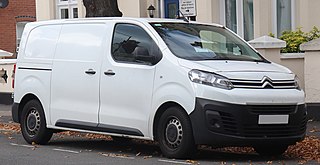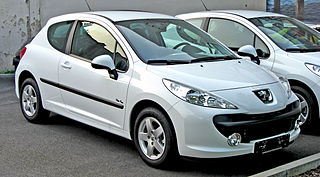
Citroën is a French automobile brand. The "Automobiles Citroën" manufacturing company was founded in 4 June 1919 by André Citroën. Citroën has been owned by Stellantis since 2021 and previously was part of the PSA Group after Peugeot acquired 89.95% share in 1976. Citroën's head office is located in the Stellantis Poissy Plant in Saint-Ouen-sur-Seine since 2021 and its offices studies and research in Vélizy-Villacoublay, Poissy (CEMR), Carrières-sous-Poissy and Sochaux-Montbéliard.

The Citroën Berlingo and Peugeot Partner are a range of vans produced since 1996 and marketed under the Citroën and Peugeot marques. They are sold as light commercial vehicles or as a passenger multi-purpose-vehicle variant with rear seats and windows. They were initially a product of the French PSA Group, which later became part of the multinational Stellantis conglomerate. The third generation has also been sold under the Opel and Vauxhall Motors marques as the Combo, by Toyota as the ProAce City from 2019, and by Fiat as the Doblò from 2022.

The PSA Group, legally known as Peugeot S.A. was a French multinational automotive manufacturing company which produced automobiles and motorcycles under the Peugeot, Citroën, DS, Opel and Vauxhall brands. On 18 December 2019, PSA and Fiat Chrysler Automobiles (FCA) announced that they had agreed to the terms of a binding $50 billion merger. On 16 July 2020, both companies announced the new name for their merged operations, Stellantis. The deal closed on 16 January 2021. As of 2022, Stellantis is the fourth largest automaker by sales behind Toyota, Volkswagen Group, and Hyundai Motor Group.

The Citroën Jumpy is a light commercial van jointly developed by FCA Italy and PSA Group, and mainly manufactured by Sevel, a joint venture between the two companies since 1994. The Jumpy was also sold as the Peugeot Expert and Fiat Scudo beginning in 1995.

The Citroën Xsara Picasso is a is a five-seater, five-door compact MPV produced by Citroën from 1999 to 2012. It was based on the Xsara hatchback platform.

The PSA EW/DW engine is a family of straight-4 black-top automobile engines manufactured by the PSA Group for use in their Peugeot and Citroën automobiles. The EW/DW family was introduced in 1998 as a replacement for the XU engine. Some DW engines are produced as part of a joint-venture with Ford Motor Company.

The Opel Combo is a panel van and leisure activity vehicle from the German automaker Opel. The Combo first appeared in 1993, a second generation model was introduced in 2001, and the third was manufactured from December 2011 to December 2017, based on the Fiat Doblò. The name "Combo" was previously applied as a suffix to a three-door panel van body style of Opel Kadett E from 1986 until 1993.

The Citroën C4 SpaceTourer, also spelled Citroen C4 SpaceTourer in some other languages, is a five-seater car produced by French manufacturer Citroën with a seven-seater version called the Grand C4 SpaceTourer also available. It has a five-door compact multi-purpose vehicle (MPV) bodystyle. The seven seat Grand C4 Picasso made its debut first, at the Paris Motor Show in September 2006, with the five seat version following in January 2007.

Fiat Professional is the brand name and subsidiary of Stellantis which manufactures light commercial vehicles and their passenger variants. It was launched on 17 April 2007 and replaced the Fiat Veicoli Commerciali division. Fiat Professional is present in the EMEA and Asia-Pacific regions; the Fiat Automobiles brand is used in the Latin America region. The Fiat Ducato and the Fiat Doblò are rebadged as the Ram ProMaster and Ram ProMaster City respectively for sale in Canada and the US.
The Stellantis Rennes Plant is one of the principal car plants in France, producing approximately 340,000 cars in 2005. The Rennes plant was acquired by the PSA Group in 1976 when Peugeot took a majority stake in the Citroën company which had built the plant.
The PF2 Platform is an automobile platform developed by engineers of the French automotive group PSA Peugeot Citroën. The platform is designed for medium cars with front wheel drive or four wheel drive coupled with electric engine and transverse engine. The first application using the PF2 platform is the 2001 Peugeot 307.
France was a pioneer in the automotive industry and is the 11th-largest automobile manufacturer in the world by 2015 unit production and the third-largest in Europe. It had consistently been the 4th-largest from the end of World War II up to 2000. It is 16% of sales of French manufactured products.

Vauxhall Ellesmere Port is a motor vehicle assembly plant, located in the town of Ellesmere Port, in Cheshire West & Chester, United Kingdom. It has always built small/medium Vauxhall/Opel vehicles, including the Vauxhall Viva and Opel/Vauxhall Astra. It is owned by the global car manufacturer Stellantis.

The Stellantis Mulhouse Plant is a major car plant in France owned by Stellantis. It has produced cars since 1972, notching up its first ten million in June 2008. Production processes include panel and component forming, welding, body painting and final assembly.

The Stellantis Trnava Plant is a major car plant in Slovakia and the most recently established Stellantis plant in Europe. It is located directly to the south-east of Trnava, approximately 60 kilometres (37 mi) from Bratislava and the frontier with Austria to the south-west.
The EMP2 is a modular car platform which is jointly developed and used by French car manufacturer PSA Group for compact and mid-size cars with front wheel drive or four wheel drive and transverse engine. It replaces the PF2 and PF3 platforms in one combined modular platform, and cost PSA €630 million to develop.

The Citroën ë-Berlingo is a battery-electric version of the Berlingo range of car-based light commercial vehicle (LCV) and multi purpose vehicles (MPV) manufactured and sold by Citroën. Rebadged versions are sold by other marques within Stellantis as the Peugeot e-Partner, Opel/Vauxhall Combo-e, and Fiat E-Doblò; in addition, Toyota sells a rebadged version as the Toyota ProAce City Electric.
The Stellantis Mangualde Plant, also known as CPMG is an automotive assembly plant located in the city of Mangualde, Portugal, near Viseu. It produces Citroën Berlingo, Peugeot Partner/Rifter, Opel Combo/Combo Life, Fiat Doblò and Vauxhall Combo in conjunction with the Stellantis Vigo Plant.

Stellantis N.V. is a multinational automotive manufacturing corporation formed from the merger in 2021 of the Italian–American conglomerate Fiat Chrysler Automobiles (FCA) and the French PSA Group. The company headquarters is in Hoofddorp, Netherlands.
Stellantis Argentina S.A. is the Argentine subsidiary of international conglomerate Stellantis which produces and markets Citroën, Fiat, and Peugeot vehicles in the country. Established in 2021, the company is successor of several firms that had operated in Argentina as subsidiaries or licensors for these brands, such as Fiat Argentina, and Groupe PSA Argentina.

















